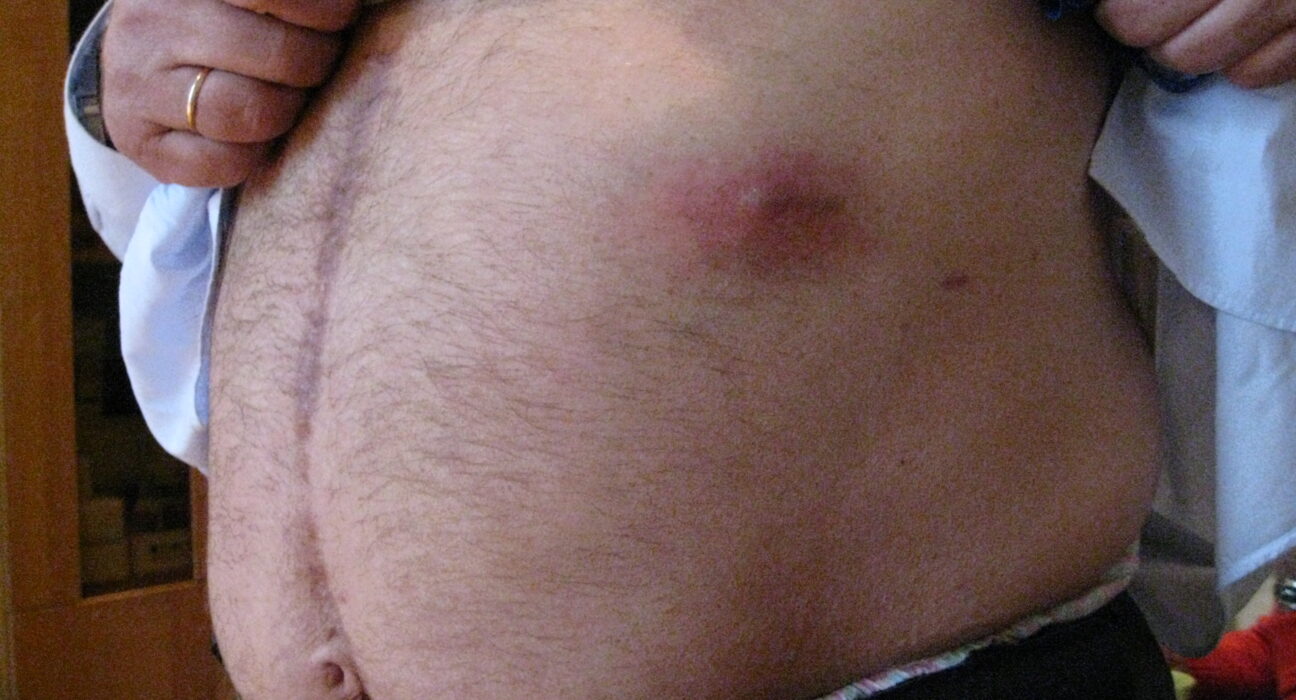What is a Belly Button? when Infected, Signs, Causes, and Solutions?

In the intricate landscape of the human body, the belly button is a fungal skin infection caused by a yeast called Candida. It causes a bright red, and often stands as a curious remnant of our earliest connection to life.
But beneath its seemingly innocuous facade lies a tale of potential peril: the saga of infection, fraught with signs, causes, and, thankfully, solutions.
What exactly is this enigmatic navel? Let’s embark on a journey of discovery to unravel the mysteries shrouding the belly button.
At first glance, the belly button appears as a mere indentation on the abdomen, a testament to our umbilical past.
Yet, this unassuming feature harbors a world of significance. Nestled within its confines are layers of tissue remnants and nerve endings, a subtle reminder of our fetal connection to maternal nourishment.
But beneath its surface lies the potential for disruption: the lurking threat of infection.
Redness, tenderness, perhaps even a foul odor emanating from the belly button. These are the signs that something is amiss, a silent cry for attention from a neglected navel.
But what causes such distress in this seemingly innocuous crevice? Bacterial invaders, fungal intruders, even viral assailants seek to infiltrate this vulnerable site, wreaking havoc within.
But fear not, for where there is darkness, there is also light. Solutions abound, from meticulous hygiene practices to targeted treatments tailored to combat the invaders within.
As we delve into the depths of the belly button, exploring its secrets, unraveling its mysteries, and emerging armed with knowledge to fend off the specter of infection.
Anatomy of the Belly Button
The belly button, or umbilicus, is a scar formed after the umbilical cord is detached at birth. It is a remnant of the umbilical cord’s attachment to the fetus in the womb.
The navel is a shallow depression in the abdomen, serving as a gateway to the abdominal cavity.
Understanding the Purpose of the Belly Button
While the belly button may seem insignificant, it serves as a reminder of our connection to maternal life support during fetal development.
Functionally, it has no vital role in adults but can harbor bacteria and fungi if not properly cared for.
What is a Belly Button?
Structure of the Belly Button
The belly button is a scar tissue located in the center of the abdomen. Its structure comprises fibrous tissues and remnants of blood vessels from the umbilical cord.
Despite its small size, it can become a site of infection under certain conditions.
Function of the Belly Button in Adults and Newborns
In adults, the belly button serves no physiological function but can accumulate dirt, sweat, and bacteria if not cleaned regularly.
In newborns, it provides a connection for the umbilical cord, delivering nutrients and oxygen to the developing fetus.
When is the Belly Button Infected
Recognizing Normal vs. Infected Belly Buttons
A normal belly button appears clean, dry, and free of redness or discharge. An infected belly button, on the other hand, may exhibit signs of inflammation, such as redness, swelling, tenderness, and discharge.
Common Causes of Belly Button Infections
Belly button infections can arise from various sources, including bacterial, fungal, and viral pathogens. Poor hygiene, moisture accumulation, and preexisting medical conditions can increase the risk of infection.
Signs of Infection
Identifying Symptoms of Belly Button Infections
Symptoms of a belly button infection may include redness, swelling, warmth, tenderness, and discharge. In severe cases, individuals may experience fever, chills, nausea, and abdominal pain.
Distinguishing Between Mild and Severe Infections
Mild infections may present with localized symptoms and respond well to conservative measures.
Severe infections, however, can lead to systemic complications and require prompt medical attention.
Causes of Belly Button Infections
Bacterial Infections: Staphylococcus, Streptococcus, and Others
Common bacterial pathogens responsible for belly button infections include Staphylococcus aureus, Streptococcus species, and Escherichia coli.
These organisms thrive in warm, moist environments and can cause skin and soft tissue infections.
Fungal Infections: Candida and Other Yeasts
Fungal infections, particularly caused by Candida species, can occur in the belly button, especially in individuals with predisposing factors such as obesity, diabetes, or immunosuppression.
These infections manifest as red, itchy, and scaly lesions.
Viral Infections: Herpes Simplex Virus, Human Papillomavirus, etc.
Viral infections of the belly button are less common but can occur, particularly in individuals with compromised immune systems.
Herpes simplex virus (HSV) and human papillomavirus (HPV) are among the viral pathogens implicated in these infections.
Risk Factors for Belly Button Infections
Factors That Increase Susceptibility to Infections
Certain factors increase the risk of developing a belly button infection; including obesity, diabetes, immunosuppression, and poor hygiene practices.
Individuals with a history of abdominal surgeries or umbilical piercings are also at higher risk.
Lifestyle Habits That Contribute to Infection Risk
Unhygienic practices, such as neglecting to clean the belly button regularly or wearing tight clothing that traps moisture, can create an environment conducive to bacterial and fungal growth.
Lifestyle choices, such as smoking and poor diet, can weaken the immune system, further predisposing individuals to infections.
Complications Associated with Belly Button Infections
Understanding Potential Complications of Untreated Infections
If left untreated, belly button infections can lead to complications such as cellulitis, abscess formation, sepsis, and peritonitis.
These complications can be life-threatening, particularly in individuals with preexisting medical conditions or compromised immune systems.
Long-Term Effects of Chronic Belly Button Infections
Chronic belly button infections can result in scarring, tissue damage, and recurrent infections. In severe cases, surgical intervention may be necessary to remove infected tissue and prevent recurrence.
Diagnosis of Belly Button Infections
Physical Examination and Medical History Assessment
Diagnosis of a belly button infection typically involves a thorough physical examination, including inspection of the belly button for signs of inflammation, tenderness, or discharge.
A detailed medical history, including any recent surgeries, piercings, or medical conditions, is also important.
Diagnostic Tests: Cultures, Swabs, and Imaging
In some cases, healthcare providers may perform diagnostic tests such as bacterial or fungal cultures of the discharge, swabs for microscopy, or imaging studies such as ultrasound or CT scan to assess the extent of the infection and rule out underlying complications.
Treatment Options for Belly Button Infections
Topical Antibiotics: Application and Effectiveness
Mild belly button infections may be treated with topical antibiotics such as mupirocin or bacitracin ointment.
These medications help eliminate bacterial pathogens and reduce inflammation when applied directly to the infected area.
Oral Medications: Prescribed Treatments for Severe Infections
Severe or systemic belly button infections may require oral antibiotics or antifungal medications to eradicate the infection and prevent complications.
These medications are prescribed by healthcare providers based on the type and severity of the infection.
Surgical Intervention: Drainage and Debridement
In cases of abscess formation or necrotizing infections, surgical intervention may be necessary to drain the abscess, remove infected tissue, and promote wound healing.
Surgical debridement helps prevent the spread of infection and reduces the risk of recurrence.
Preventive Measures to Avoid Belly Button Infections
Maintaining Proper Hygiene: Cleaning and Drying Techniques
Preventive measures for belly button infections include maintaining proper hygiene by cleaning the belly button regularly with mild soap and water, followed by thorough drying to prevent moisture buildup.
Avoiding Irritants and Allergens: Clothing and Products
Avoiding irritants and allergens, such as harsh soaps, perfumes, and abrasive clothing, can reduce the risk of skin irritation and inflammation in the belly button area.
Choosing breathable fabrics and hypoallergenic products can help prevent allergic reactions and skin sensitivities.
Promoting Healthy Lifestyle Habits: Diet and Exercise
Adopting a healthy lifestyle, including a balanced diet rich in nutrients and regular exercise, can strengthen the immune system and reduce the risk of infections.
Maintaining a healthy weight and managing underlying medical conditions such as diabetes can also help prevent belly button infections.
Home Remedies for Belly Button Infections
Natural Remedies
Some individuals may find relief from belly button infections using natural remedies such as tea tree oil, aloe vera gel, or diluted vinegar solutions.
These remedies have antimicrobial properties and may help reduce inflammation and promote healing.
Over-the-Counter Treatments
Over-the-counter treatments for belly button infections include antifungal creams, antibacterial ointments, and hydrocortisone creams to reduce itching and inflammation.
These medications are available without a prescription and can be used as directed for mild infections.

When to Seek Medical Attention
Recognizing When Self-Treatment is Not Sufficient
If symptoms of a belly button infection persist or worsen despite home remedies or over-the-counter treatments, it is important to seek medical attention promptly.
Delaying treatment can lead to complications and may require more aggressive intervention.
Urgent Signs That Require Immediate Medical Care
Urgent signs that require immediate medical care for a belly button infection include high fever, severe pain, spreading redness, or signs of systemic infection such as chills, nausea, or confusion. These symptoms may indicate a severe infection or complications that require urgent evaluation and treatment.
Educational Campaigns and Public Awareness
Raising Awareness about Belly Button Infections
Educational campaigns and public awareness initiatives play a crucial role in educating individuals about the risks, signs, and prevention of belly button infections.
By raising awareness, healthcare providers can empower individuals to recognize and address infections early to prevent complications.
Dispelling Myths and Misconceptions
Dispelling myths and misconceptions surrounding belly button infections is essential for promoting accurate information and preventing unnecessary anxiety or delay in seeking treatment.
By addressing common misconceptions, healthcare providers can improve understanding and encourage proactive management of infections.
Conclusion
Belly button infections can range from mild irritation to severe systemic infections with potentially life-threatening complications.
Recognizing the signs, understanding the causes, and adopting preventive measures are essential for maintaining optimal belly button health.
By educating individuals about belly button infections and promoting proactive management strategies, healthcare providers can empower individuals to take control of their health and minimize the risk of complications associated with these infections.









